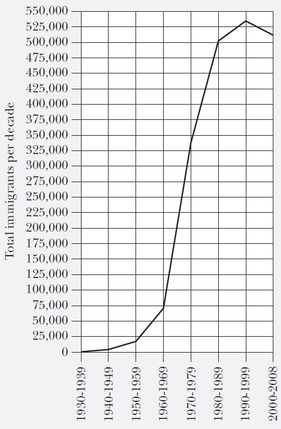|
Written by Thomas Le The diversity in America is one of its defining features. The country has earned its reputation as one of the most ethnically diverse nations in the world. Asians are no exception, however, one underrepresented group when addressing the topic of Asian immigration to the United States are the Filipinos. Acquired as a territory from Spain by the United States in 1989 after the latter’s victory in the Spanish-American War with the signing of the Treaty of Paris, the Philippines is home to around 106.7 citizens, all spread out on its 1,700 islands. Being a U.S. territory, newly gained citizenship allowed for several huge waves of immigrants to find new life in the states. This first and most wave was immediately after the annexation of the Philippines by the United States. The immigrants, usually settling in states on the west coast such as California, were very limited in their numbers, with only around a few hundred settling in the 1930’s. This was mainly due to the passing of the Tydings-McDuffie Act which restricted the number of Filipino immigrants 100 per year. Throughout WW2, where Filipino soldiers actively fought against Japanese expansion alongside the United States. In recognition of their valiant efforts, the United States passed both the Filipino Naturalization Bill and the War Brides Act which gave any man and his who served in the military their wife the opportunity to become U.S. citizens. The bill warranted more than also allowed for any Filipinos currently living in the U.S. to also become citizens. By the years following the end of war, the Philippines had gained its independence with the Treaty of Manila in 1946 and up onto the 1960’s, as many as 65,000 veterans and their wives immigrated to the United States. People other than veterans also came to the U.S. as in 1948, the U.S. Congress passed the Education Exchange Act, which enabled foreign nurses to spend two years in the United States for study and professional experience, and joined the other legislations that promoted the immigration of a new category of Filipinos who would join the growing Filipino American population. Immediately after the second wave, the third most notable wave of immigration hit in 1965 when President Lyndon B. Johnson passed the Immigration and Nationality Act, which ended national quotas, and provided an unlimited number of visas for family reunification. Numbers skyrocketed as by the end of the 20th century, the amount of immigrants had shot up from 75,000 in 1961 to 550,000 in 2000, and ever since then, the population has been steadily growing. Now, with over 4 million members living all over the United States, the Filipino community continues to spread its influence of culture with figures such as Bruno Mars becoming one of the most popular artists of the 21st century to Ben Cayetano who served as the fifth governor of the United States. Sources
1 Comment
|
Description
For the 2020-21 season, REACH will be releasing a new blog post written by our officers during the first and third Wednesdays of each month about different aspects of Asian culture, such as pop culture, conflicts faced, representation in media, history, celebration and holidays, and stereotypes. We hope you enjoy reading them! Archives
March 2021
Categories |


 RSS Feed
RSS Feed
